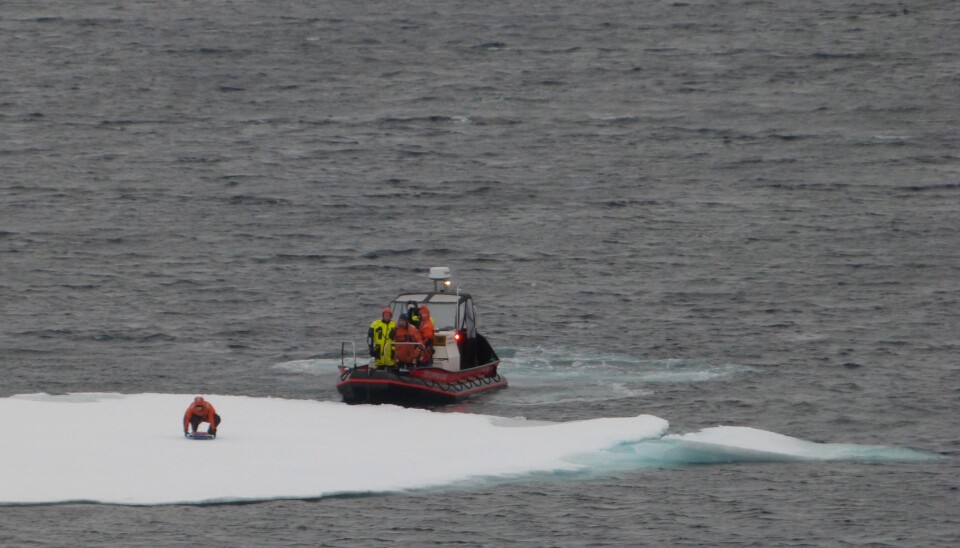
A handful of suitcases teach us how waves and sea ice interact, and improve weather and climate models
Waves marching through the sea ice is an amazing view. It is as if a white, snow-covered landscape suddenly starts gently undulating, the solid ground dancing rhythmically. The waves’ wildness from the open sea is tamed and dampened by the ice. Yet, the waves’ energy can break solid sea ice, greatly affecting sea ice drift, formation and melt. Hence, waves in ice are an important - yet not well understood - factor in the arctic physical environment.
The need for suitcases in the age of satellites
Satellites have been monitoring arctic sea ice distribution since the 1970s and have provided us with an unprecedented amount of information on a changing environment.
Yet, retrieving information on waves in ice-covered waters from satellite measurements is still challenging, and consequently our understanding of this process is limited. Improved understanding and modelling wave propagation in sea ice would increase the accuracy of the wave and ocean models used in climate, weather and sea state predictions.
Better weather and sea state forecasts are becoming more important in the Arctic, where ship traffic and other human activity is increasing.
The suitcases
As the satellites’ ability to measure waves in ice is still limited, measurements have to be retrieved in the field, by placing wave buoys on ice floes. Commercial wave buoys are expensive and not designed for being placed on the sea ice.
This is why researchers from UiO and MET have developed a cheaper, open source instrument: Small orange suitcases, and recently even smaller watertight plastic cases. In many ways, these suitcases are not much more than bulky smartwatches, as they contain a small computer, a GPS, and a high-precision accelerometer. In smartwatches, accelerometers are used for counting your steps. In the suitcases, the accelerometers record the vertical movement of the suitcases. Place the suitcases on sea ice, and the accelerometer will precisely tell us how much and how fast the sea ice moves up and down.
Jean Rabault (now at MET) started designing and putting together the first wave loggers while he was working on his PhD together with Professor Atle Jensen at UiO. Now he has developed a new generation of even smaller instruments together with Malte Müller, MET, slashing the cost to a few thousand Norwegian kroner a piece. This means we can deploy many more, and perhaps answer the question of how quickly waves are damped by the sea ice.
But even more important is the question of how waves break up the ice, or how waves keep the ice broken up. This is extremely important for measuring the amount of heat that escapes from the ocean, because fast ice (unbroken) effectively puts a lid on the ocean whereas ice floes with gaps between them are quite “leaky”.
16 suitcases on the ice
The Nansen Legacy has helped fund the 16 suitcases that have so far been put out on the sea ice.
Four instruments were deployed in the marginal ice zone north of Svalbard in September 2018, six on the Yamal plateau during the summer of 2020, and recently another six suitcases and nine of the new, smaller, wave loggers were deployed east of Svalbard in February 2021. In addition, an ultrasonic companion to the suitcases has been mounted on the bow of R/V Kronprins Haakon to measure waves in both the open ocean and the sea ice.
The scientists were able to measure how much the wave height differs between open and ice-covered waters with the help of the four suitcases deployed during the Nansen Legacy cruise in September 2018. Just a few days after the first suitcases had been placedon the ice,gale-force winds swept in from the ocean. The wave height was over three meters in the open ocean, but the accelerometers in the suitcases showed that the waves in the ice was less than a meter. Just how rapidly the waves are damped as they enter the sea ice is a “hot” topic (or cool?). This will be further explored with the deployments done during the last Nansen Legacy cruise, where a total of 15 wave loggers were deployed.
“The data collected gives us a unique opportunity to tune both sea ice drift models and models of waves in ice, which will ultimately help improve weather and wave forecasts.”
References:
Løken T, Rabault J, Thomas EE, Müller M, Christensen KH, Sutherland G, Jensen A (2020) A comparison of wave observations in the Arctic marginal ice zone with spectral models. Atmospheric and Oceanic Physics. arXiv:2003.09472v3
Rabault J, Sutherland G, Gundersen O, Jensen A, Marchenko A, Breivik Ø (2020) An open source, versatile, affordable waves in ice instrument for scientific measurements in the Polar Regions. Cold Regions Science and Technology 170: 102955







